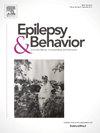The long-term effects of limbic non-convulsive status epilepticus in peri-adolescent rats
IF 2.3
3区 医学
Q2 BEHAVIORAL SCIENCES
引用次数: 0
Abstract
To optimize the clinical approach to non-convulsive status epilepticus (NCSE), it is essential to gain insight into its long-term effects on cognition and behaviors. Here, we investigated limbic NCSE-induced hippocampal injury and behavioral deficits in peri-adolescent rats. NCSE was induced in P43 Sprague Dawley rats with intrahippocampal subconvulsive doses of kainic acid (NCSE group, n = 14) under continuous epidural cortical electroencephalography (EEG). Controls received volume-matched saline (n = 18). Following one month of continuous EEG monitoring, rats were sequentially subjected (P73-91) to the open field, the Morris water maze (MWM), and the modified two-way active avoidance (MAAV). Rats were sacrificed at P91 to histologically assess hippocampal injury with NeuN (neuronal nuclei) staining, levels of GFAP (glial fibrillary acidic protein), and synaptophysin (Syp). Following kainic acid administration, the NCSE group experienced electroclinical seizures characterized by behavioral arrest and oromotor automatisms without tonic-clonic activity (latency: 15.93 ± 4.70 min, duration: 68.35 ± 17.97 min). There were no seizure recurrences in the rest of the long-term recordings. Compared to controls, NCSE rats had impaired place learning in the MWM, and lower rates of context-cued shock avoidance in the MAAV (p < 0.05). The NCSE and control groups had comparable hippocampal neuronal densities and GFAP levels, but NCSE rats had significantly lower hilar Syp levels. One episode of limbic NCSE during peri-adolescence results in later life hippocampal synaptic dysfunction and contextual learning deficits. These data suggest that the diagnosis and treatment of NCSE should be prompt.
围青春期大鼠肢体非惊厥性癫痫状态的长期影响。
为了优化非惊厥性癫痫状态(NCSE)的临床治疗方法,了解其对认知和行为的长期影响至关重要。在这里,我们研究了肢体NCSE诱导的围青春期大鼠海马损伤和行为缺陷。在连续硬膜外皮层脑电图(EEG)检查下,用海马内亚惊厥剂量的凯尼酸(NCSE 组,n = 14)诱导 P43 Sprague Dawleyrats 的 NCSE。对照组接受体积匹配的生理盐水(n = 18)。连续脑电图监测一个月后,依次(P73-91)对大鼠进行开阔地、莫里斯水迷宫(MWM)和改良双向主动回避(MAAV)实验。大鼠在P91时被处死,用NeuN(神经元核)染色、GFAP(胶质纤维酸性蛋白)和突触素(Syp)水平对海马损伤进行组织学评估。服用凯尼酸后,NCSE 组出现临床电痉挛,其特征是行为停止和口动自动症,但无强直阵挛活动(潜伏期:15.93 ± 4.70 分钟,持续时间:68.35 ± 17.97 分钟)。在其余的长期记录中没有癫痫复发。与对照组相比,NCSE 大鼠在 MWM 中的位置学习能力受损,在 MAAV 中的情境诱导休克回避率较低(p
本文章由计算机程序翻译,如有差异,请以英文原文为准。
求助全文
约1分钟内获得全文
求助全文
来源期刊

Epilepsy & Behavior
医学-行为科学
CiteScore
5.40
自引率
15.40%
发文量
385
审稿时长
43 days
期刊介绍:
Epilepsy & Behavior is the fastest-growing international journal uniquely devoted to the rapid dissemination of the most current information available on the behavioral aspects of seizures and epilepsy.
Epilepsy & Behavior presents original peer-reviewed articles based on laboratory and clinical research. Topics are drawn from a variety of fields, including clinical neurology, neurosurgery, neuropsychiatry, neuropsychology, neurophysiology, neuropharmacology, and neuroimaging.
From September 2012 Epilepsy & Behavior stopped accepting Case Reports for publication in the journal. From this date authors who submit to Epilepsy & Behavior will be offered a transfer or asked to resubmit their Case Reports to its new sister journal, Epilepsy & Behavior Case Reports.
 求助内容:
求助内容: 应助结果提醒方式:
应助结果提醒方式:


